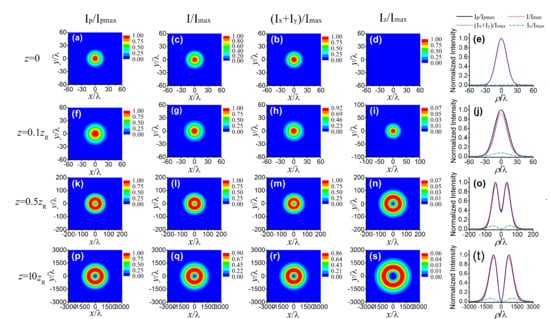Nonparaxial Propagation Properties of Specially Correlated Radially Polarized Beams in Free Space
Abstract
:1. Introduction
2. Nonparaxial Propagation Theory of an SCRP Beam
3. Statistical Properties of a Nonparaxial SCRP Beam
4. Conclusions
Author Contributions
Funding
Conflicts of Interest
Appendix A
References
- Zhan, Q. Cylindrical vector beams: From mathematical concepts to applications. Adv. Opt. Photonics 2009, 1, 1–57. [Google Scholar] [CrossRef]
- Ehmke, T.; Nitzsche, T.H.; Knebl, A.; Heisterkamp, A. Molecular orientation sensitive second harmonic microscopy by radially and azimuthally polarized light. Biomed. Opt. Express 2014, 5, 2231–2246. [Google Scholar] [CrossRef] [PubMed]
- Dorn, R.; Quabis, S.; Leuchs, G. Sharper focus for a radially polarized light beam. Phys. Rev. Lett. 2003, 91, 233901. [Google Scholar] [CrossRef] [PubMed]
- Zhan, Q. Radiation forces on a dielectric sphere produced by highly focused cylindrical vector beams. J. Opt. A 2003, 5, 229–232. [Google Scholar] [CrossRef]
- Jia, B.; Kang, H.; Li, J.; Gu, M. Use of radially polarized beams in three-dimensional photonic crystal fabrication with the two-photon polymerization method. Opt. Lett. 2009, 34, 1918–1920. [Google Scholar] [CrossRef] [PubMed]
- Ahmadivand, A.; Gerislioglu, B.; Pala, N. Azimuthally and radially excited charge transfer plasmon and Fano lineshapes in conductive sublayer-mediated nanoassemblies. J. Opt. Soc. Am. A 2017, 34, 2052–2056. [Google Scholar] [CrossRef] [PubMed]
- Xu, J.; Li, K.; Zhang, S.; Lu, X.; Shi, N.; Tan, Z.; Lu, Y.; Liu, N.; Zhang, B.; Liang, Z. Field-enhanced nanofocusing of radially polarized light by a tapered hybrid plasmonic waveguide with periodic grooves. Appl. Opt. 2019, 58, 588–592. [Google Scholar] [CrossRef] [PubMed]
- Dong, Y.; Cai, Y.; Zhao, C.; Yao, M. Statistics properties of a cylindrical vector partially coherent beam. Opt. Express 2011, 19, 5979–5992. [Google Scholar] [CrossRef] [PubMed]
- Wang, F.; Cai, Y.; Dong, Y.; Korotkova, O. Experimental generation of a radially polarized beam with controllable spatial coherence. Appl. Phys. Lett. 2012, 100, 051108. [Google Scholar] [CrossRef]
- Wang, F.; Liu, X.; Liu, L.; Yuan, Y.; Cai, Y. Experimental study of the scintillation index of a radially polarized beam with controllable spatial coherence. Appl. Phys. Lett. 2013, 103, 091102. [Google Scholar] [CrossRef]
- Guo, L.; Chen, Y.; Liu, X.; Liu, L.; Cai, Y. Vortex phase-induced changes of the statistical properties of a partially coherent radially polarized beam. Opt. Express 2016, 24, 13714–13728. [Google Scholar] [CrossRef] [PubMed]
- Liu, L.; Peng, X.; Chen, Y.; Guo, L.; Cai, Y. Statistical properties of a radially polarized twisted Gaussian Schell-model beam in a uniaxial crystal. J. Mod. Opt. 2017, 64, 698–708. [Google Scholar] [CrossRef]
- Zhang, Y.; Cui, Y.; Wang, F.; Cai, Y. Correlation singularities in a partially coherent electromagnetic beam with initially radial polarization. Opt. Express 2015, 23, 11483–11492. [Google Scholar] [CrossRef] [PubMed]
- Zhu, S.; Wang, F.; Chen, Y.; Li, Z.; Cai, Y. Statistical properties in Young’s interference pattern formed with a radially polarized beam with controllable spatial coherence. Opt. Express 2014, 22, 28697–28710. [Google Scholar] [CrossRef] [PubMed]
- Cai, Y.; Chen, Y.; Wang, F. Generation and propagation of partially coherent beams with nonconventional correlation functions: A review [invited]. J. Opt. Soc. Am. A 2014, 31, 2083–2096. [Google Scholar] [CrossRef] [PubMed]
- Mei, Z.; Korotkova, O. Random sources generating ring-shaped beams. Opt. Lett. 2013, 38, 91–93. [Google Scholar] [CrossRef] [PubMed]
- Yu, J.; Cai, Y.; Gbur, G. Rectangular Hermite non-uniformly correlated beams and its propagation properties. Opt. Express 2018, 26, 27894–27906. [Google Scholar] [CrossRef] [PubMed]
- Wang, F.; Liang, C.; Cai, Y.; Yuan, Y. Generalized multi-Gaussian correlated Schell-model beam: From theory to experiment. Opt. Express 2014, 22, 23456–23464. [Google Scholar] [CrossRef] [PubMed]
- Chen, Y.; Wang, F.; Yu, J.; Liu, L.; Cai, Y. Vector Hermite-Gaussian correlated Schell-model beam. Opt. Express 2016, 24, 15232–15250. [Google Scholar] [CrossRef] [PubMed]
- Zhao, D.; Wan, L. Optical coherence grids and their propagation characteristics. Opt. Express 2018, 26, 2168–2180. [Google Scholar] [CrossRef]
- Chen, Y.; Wang, F.; Liu, L.; Zhao, C.; Cai, Y.; Korotkova, O. Generation and propagation of a partially coherent vector beam with special correlation functions. Phys. Rev. A 2014, 89, 013801. [Google Scholar] [CrossRef]
- Zhang, J.; Wang, J.; Huang, H.; Wang, H.; Zhu, S.; Li, Z.; Lu, J. Propagation Characteristics of a Twisted Cosine-Gaussian Correlated Radially Polarized Beam. Appl. Sci. 2018, 8, 1485. [Google Scholar] [CrossRef]
- Santarsiero, F.; Gori, M. Devising genuine spatial correlation functions. Opt. Lett. 2007, 32, 3531–3533. [Google Scholar] [CrossRef]
- Gori, F.; Ramírezsánchez, V.; Santarsiero, M.; Shirai, T. On genuine cross-spectral density matrices. J. Opt. A 2009, 11, 85706–85707. [Google Scholar] [CrossRef]
- Martínez-Herrero, R.; Mejías, P.; Gori, F. Genuine cross-spectral densities and pseudo-modal expansions. Opt. Lett. 2009, 34, 1399–1401. [Google Scholar] [CrossRef] [PubMed]
- Martínez-Herrero, R.; Mejías, P.M. Elementary-field expansions of genuine cross-spectral density matrices. Opt. Lett. 2009, 34, 2303–2305. [Google Scholar] [CrossRef] [PubMed]
- Wang, F.; Yu, J.; Liu, X.; Cai, Y. Research progress of partially coherent beams propagation in turbulent atmosphere. Acta Phys. Sin. 2018, 67, 184203. [Google Scholar] [CrossRef]
- Liang, C.; Wu, G.; Wang, F.; Li, W.; Cai, Y.; Ponomarenko, S.A. Overcoming the classical Rayleigh diffraction limit by controlling two-point correlations of partially coherent light sources. Opt. Express 2017, 25, 28352–28362. [Google Scholar] [CrossRef]
- Yu, J.; Wang, F.; Liu, L.; Cai, Y.; Gbur, G. Propagation properties of Hermite non-uniformly correlated beams in turbulence. Opt. Express 2018, 26, 27894–27906. [Google Scholar] [CrossRef] [PubMed]
- Zhou, Y.; Xu, H.F.; Yuan, Y.; Peng, J.; Qu, J.; Huang, W. Trapping two types of particles using a Laguerre-Gaussian correlated Schell-model beam. IEEE Photon. J. 2016, 8, 1–10. [Google Scholar] [CrossRef]
- Liu, X.; Zhao, D. Trapping two types of particles with a focused generalized Multi-Gaussian Schell model beam. Opt. Commun. 2015, 354, 250–255. [Google Scholar] [CrossRef]
- Dao, W.; Liang, C.; Wang, F.; Cai, Y.; Hoenders, B. Effects of Anisotropic Turbulence on Propagation Characteristics of Partially Coherent Beams with Spatially Varying Coherence. Appl. Sci. 2018, 8, 2025. [Google Scholar] [CrossRef]
- Rubinsztein-Dunlop, H.; Forbes, A.; Berry, M.V.; Dennis, M.R.; Andrews, D.L.; Mansuripur, M.; Denz, C.; Alpmann, C.; Banzer, P.; Bauer, T. Roadmap on structured light. J. Opt. 2016, 19, 013001. [Google Scholar] [CrossRef] [Green Version]
- Dholakia, K.; Čižmár, T. Shaping the future of manipulation. Nat. Photon. 2011, 5, 335. [Google Scholar] [CrossRef]
- Leach, J.; Jack, B.; Romero, J.; Jha, A.K.; Yao, A.M.; Franke-Arnold, S.; Ireland, D.G.; Boyd, R.W.; Barnett, S.M.; Padgett, M. Quantum correlations in optical angle–orbital angular momentum variables. Science 2010, 329, 662–665. [Google Scholar] [CrossRef] [PubMed]
- Sarenac, D.; Cory, D.G.; Nsofini, J.; Hincks, I.; Miguel, P.; Arif, M.; Clark, C.W.; Huber, M.G.; Pushin, D.A. Generation of a lattice of spin-orbit beams via coherent averaging. Phys. Rev. Lett. 2018, 121, 183602. [Google Scholar] [CrossRef] [PubMed]
- Cui, Y.; Wei, C.; Zhang, Y.; Wang, F.; Cai, Y. Effect of the atmospheric turbulence on a special correlated radially polarized beam on propagation. Opt. Commun. 2015, 354, 353–361. [Google Scholar] [CrossRef]
- Wang, F.; Chen, Y.; Liu, X.; Cai, Y.; Ponomarenko, S.A. Self-reconstruction of partially coherent light beams scattered by opaque obstacles. Opt. Express 2016, 24, 23735–23746. [Google Scholar] [CrossRef] [PubMed]
- Naqwi, A.; Durst, F. Focusing of diode laser beams: A simple mathematical model. Appl. Opt. 1990, 29, 1780–1785. [Google Scholar] [CrossRef] [PubMed]
- Borghi, R.; Santarsiero, M.; Alonso, M.A. Highly focused spirally polarized beams. J. Opt. Soc. Am. A 2005, 22, 1420–1431. [Google Scholar] [CrossRef]
- Chaumet, P.C. Vision. Fully vectorial highly nonparaxial beam close to the waist. J. Opt. Soc. Am. A 2006, 23, 3197–3202. [Google Scholar] [CrossRef]
- Zhang, P.; Hu, Y.; Cannan, D.; Salandrino, A.; Li, T.; Morandotti, R.; Zhang, X.; Chen, Z. Generation of linear and nonlinear nonparaxial accelerating beams. Opt. Lett. 2012, 37, 2820–2822. [Google Scholar] [CrossRef] [PubMed]
- Alexandre, A.; Michel, P. 4π Focusing of TM(01) beams under nonparaxial conditions. Opt. Express 2010, 18, 22128–22140. [Google Scholar] [CrossRef]
- Moon, H.J.; Chough, Y.T.; An, K. Cylindrical microcavity laser based on the evanescent-wave-coupled gain. Phys. Rev. Lett. 2000, 85, 3161–3164. [Google Scholar] [CrossRef] [PubMed]
- Sung, S.-Y.; Lee, Y.-G. Trapping of a micro-bubble by non-paraxial Gaussian beam: Computation using the FDTD method. Opt. Express 2008, 16, 3463–3473. [Google Scholar] [CrossRef] [PubMed]
- Balázs, G.; Pál, K.; Attila, B.G.; Emőke, L. Computer simulation of reflective volume grating holographic data storage. J. Opt. Soc. Am. A 2007, 24, 2075–2081. [Google Scholar] [CrossRef]
- Kuittinen, M.; Vahimaa, P.; Honkanen, M.; Turunen, J. Beam shaping in the nonparaxial domain of diffractive optics. Appl. Opt. 1997, 36, 2034–2041. [Google Scholar] [CrossRef] [PubMed]
- Sung, Y.; Sheppard, C.J.R. Three-dimensional imaging by partially coherent light under nonparaxial condition. J. Opt. Soc. Am. A 2011, 28, 554–559. [Google Scholar] [CrossRef] [PubMed]
- Duan, K.; Lü, B. Wigner-distribution-function matrix and its application to partially coherent vectorial nonparaxial beams. J. Opt. Soc. Am. B 2005, 22, 1585–1593. [Google Scholar] [CrossRef]
- Porras, M.A. Non-paraxial vectorial moment theory of light beam propagation. Opt. Commun. 1996, 127, 79–95. [Google Scholar] [CrossRef]
- Duan, K.; Lü, B. Partially coherent vectorial nonparaxial beams. J. Opt. Soc. Am. A 2004, 21, 1924–1932. [Google Scholar] [CrossRef]
- Ciattoni, A.; Porto, P.D.; Crosignani, B.; Yariv, A. Vectorial nonparaxial propagation equation in the presence of a tensorial refractive-index perturbation. J. Opt. Soc. Am. B 2000, 17, 809–819. [Google Scholar] [CrossRef]
- Luneburg, R.K. Mathematical Theory of Optics; University of California Press: Berkeley, CA, USA, 1966. [Google Scholar]
- Wang, X.; Liu, Z.; Zhao, D. Nonparaxial propagation of Lorentz-Gauss beams in uniaxial crystal orthogonal to the optical axis. J. Opt. Soc. Am. A 2014, 31, 872–878. [Google Scholar] [CrossRef] [PubMed]
- Zhang, P.; Hu, Y.; Li, T.; Cannan, D.; Yin, X.; Morandotti, R.; Chen, Z.; Zhang, X. Nonparaxial Mathieu and Weber Accelerating Beams. Phys. Rev. Lett. 2012, 109, 193901. [Google Scholar] [CrossRef] [PubMed] [Green Version]
- Deng, D.; Gao, Y.; Zhao, J.; Zhang, P.; Chen, Z. Three-dimensional nonparaxial beams in parabolic rotational coordinates. Opt. Lett. 2013, 38, 3934–3936. [Google Scholar] [CrossRef] [PubMed]
- Volyar, A.V.; Fadeeva, T.A.; Shvedov, V.G. Topological phase in a nonparaxial Gaussian beam. Tech. Phys. Lett. 1999, 25, 891–893. [Google Scholar] [CrossRef]
- Klaassen, T.; Hoogeboom, A.; van Exter, M.P.; Woerdman, J.P. Gouy phase of nonparaxial eigenmodes in a folded resonator. J. Opt. Soc. Am. A 2004, 21, 1689–1693. [Google Scholar] [CrossRef]
- Kotlyar, V.V.; Kovalev, A.A.; Soifer, V.A. Nonparaxial Hankel vortex beams of the first and second types. Comp. Opt. 2015, 39, 299–304. [Google Scholar] [CrossRef]
- Deng, D.; Guo, Q.; Wu, L.; Yang, X. Propagation of radially polarized elegant light beams. J. Opt. Soc. Am. B 2007, 24, 636–643. [Google Scholar] [CrossRef]
- Kovalev, A.A.; Kotlyar, V.V. Nonparaxial propagation of a Gaussian optical vortex with initial radial polarization. J. Opt. Soc. Am. A 2010, 27, 372–380. [Google Scholar] [CrossRef]
- Santarsiero, M.; Borghi, R. Nonparaxial propagation of spirally polarized optical beams. J. Opt. Soc. Am. A 2004, 21, 2029–2037. [Google Scholar] [CrossRef]
- Dong, Y.; Feng, F.; Chen, Y.; Zhao, C.; Cai, Y. Statistical properties of a nonparaxial cylindrical vector partially coherent field in free space. Opt. Express 2012, 20, 15908–15927. [Google Scholar] [CrossRef] [PubMed]
- Yuan, Y.; Du, S.; Dong, Y.; Wang, F.; Zhao, C.; Cai, Y. Nonparaxial propagation properties of a vector partially coherent dark hollow beam. J. Opt. Soc. Am. A 2013, 30, 1358–1372. [Google Scholar] [CrossRef] [PubMed]
- Zhang, L.; Cai, Y. Propagation of a twisted anisotropic Gaussian Schell-model beam beyond the paraxial approximation. Appl. Phys. B 2010, 103, 1001–1008. [Google Scholar] [CrossRef]
- Mandel, L.; Wolf, E. Optical Coherence and Quantum Optics; Cambridge university press: Cambridge, UK, 1995; ISBN 0521417112. [Google Scholar]
- Ciattoni, A.; Crosignani, B.; Porto, P.D. Vectorial analytical description of propagation of a highly nonparaxial beam. Opt. Commun. 2002, 202, 17–20. [Google Scholar] [CrossRef]
- Lü, B.; Duan, K. Nonparaxial propagation of vectorial Gaussian beams diffracted at a circular aperture. Opt. Lett. 2003, 28, 2440–2442. [Google Scholar] [CrossRef] [PubMed]
- Gradshteyn, I.S.; Ryzhik, I.M. Table of Integrals, Series, and Products, 7th ed.; Jeffrey, A., Zwillinger, D., Eds.; Academic press: London, UK, 2007; ISBN 9780123736376. [Google Scholar]
- Lindfors, K.; Setälä, T.; Kaivola, M.; Friberg, A.T. Degree of polarization in tightly focused optical fields. J. Opt. Soc. Am. A 2005, 22, 561–568. [Google Scholar] [CrossRef]
- Ellis, J.; Dogariu, A.; Ponomarenko, S.; Wolf, E. Degree of polarization of statistically stationary electromagnetic fields. Opt. Commun. 2005, 248, 333–337. [Google Scholar] [CrossRef]
- Setälä, T.; Shevchenko, A.; Kaivola, M.; Friberg, A.T. Degree of polarization for optical near fields. Phys. Rev. E 2002, 66, 016615. [Google Scholar] [CrossRef] [PubMed]
- Korotkova, O.; Wolf, E. Spectral degree of coherence of a random three-dimensional electromagnetic field. J. Opt. Soc. Am. A 2004, 21, 2382–2385. [Google Scholar] [CrossRef]
- Wu, G.; Wang, F.; Cai, Y. Coherence and polarization properties of a radially polarized beam with variable spatial coherence. Opt. Express 2012, 20, 28301–28318. [Google Scholar] [CrossRef] [PubMed]
- Qiu, Y.; Liu, J.; Chen, Z. Propagation properties of radially polarized partially coherent LG (0, 1)∗ beams. Opt. Commun. 2009, 282, 69–73. [Google Scholar] [CrossRef]

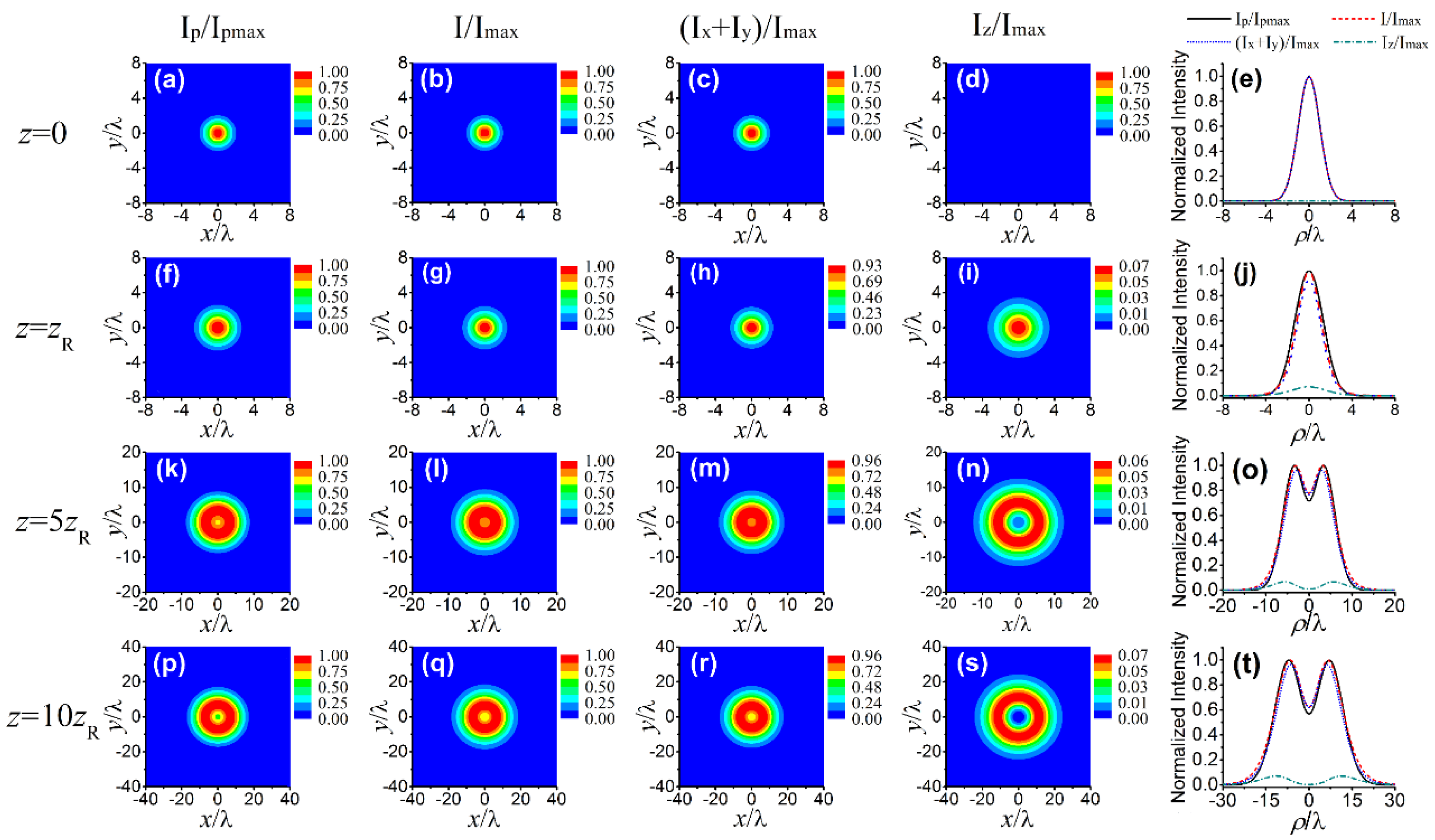

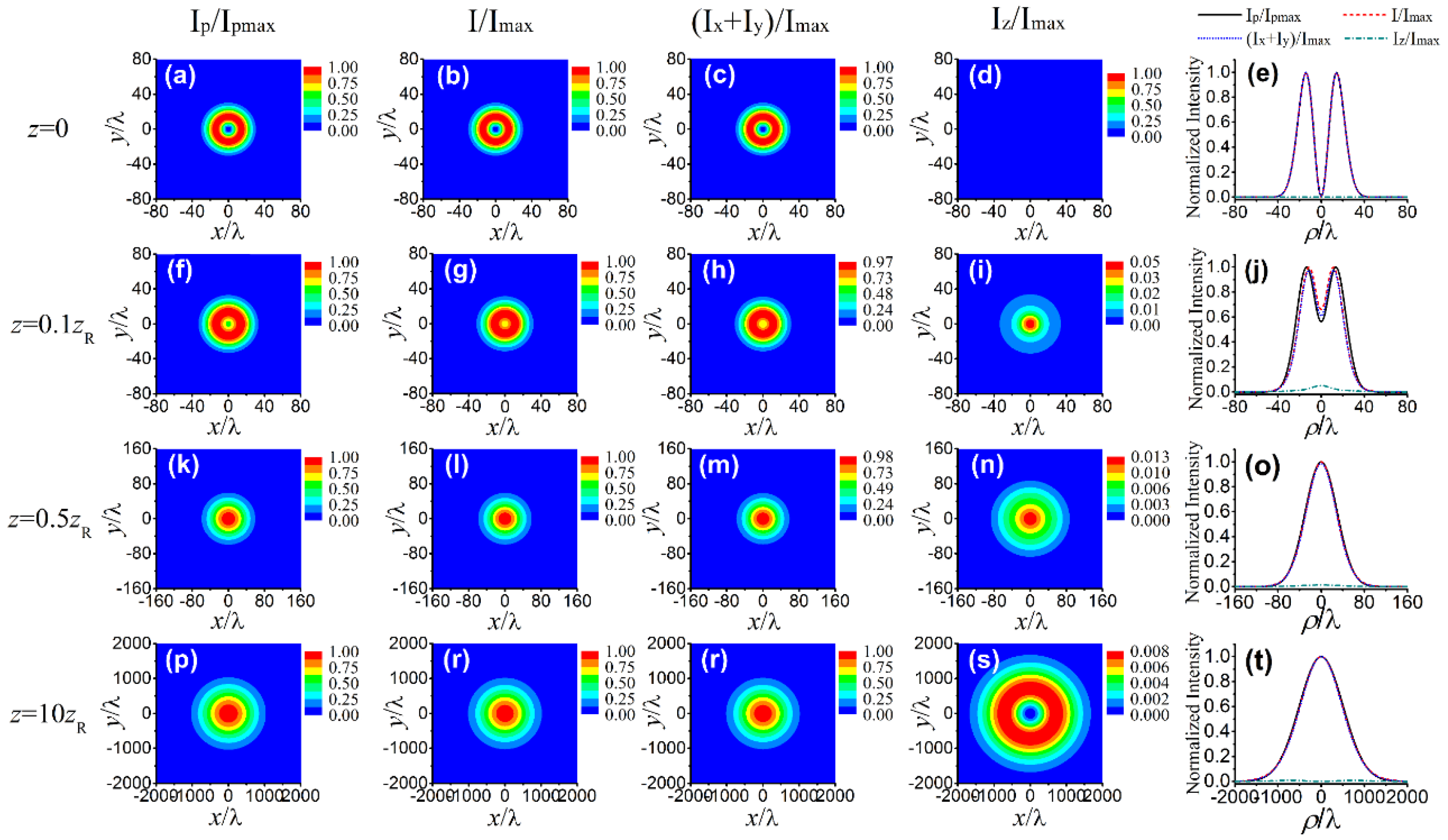
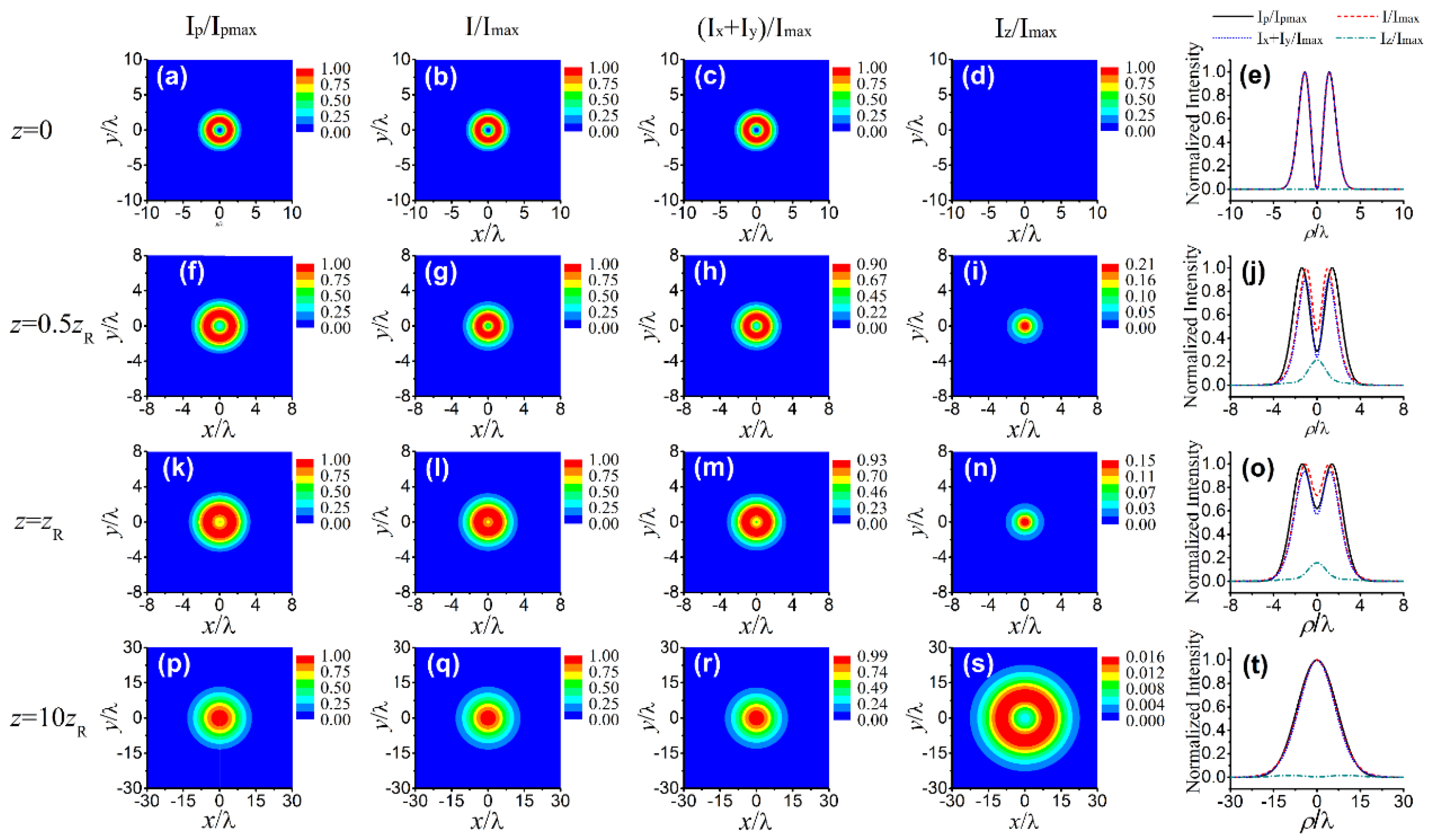
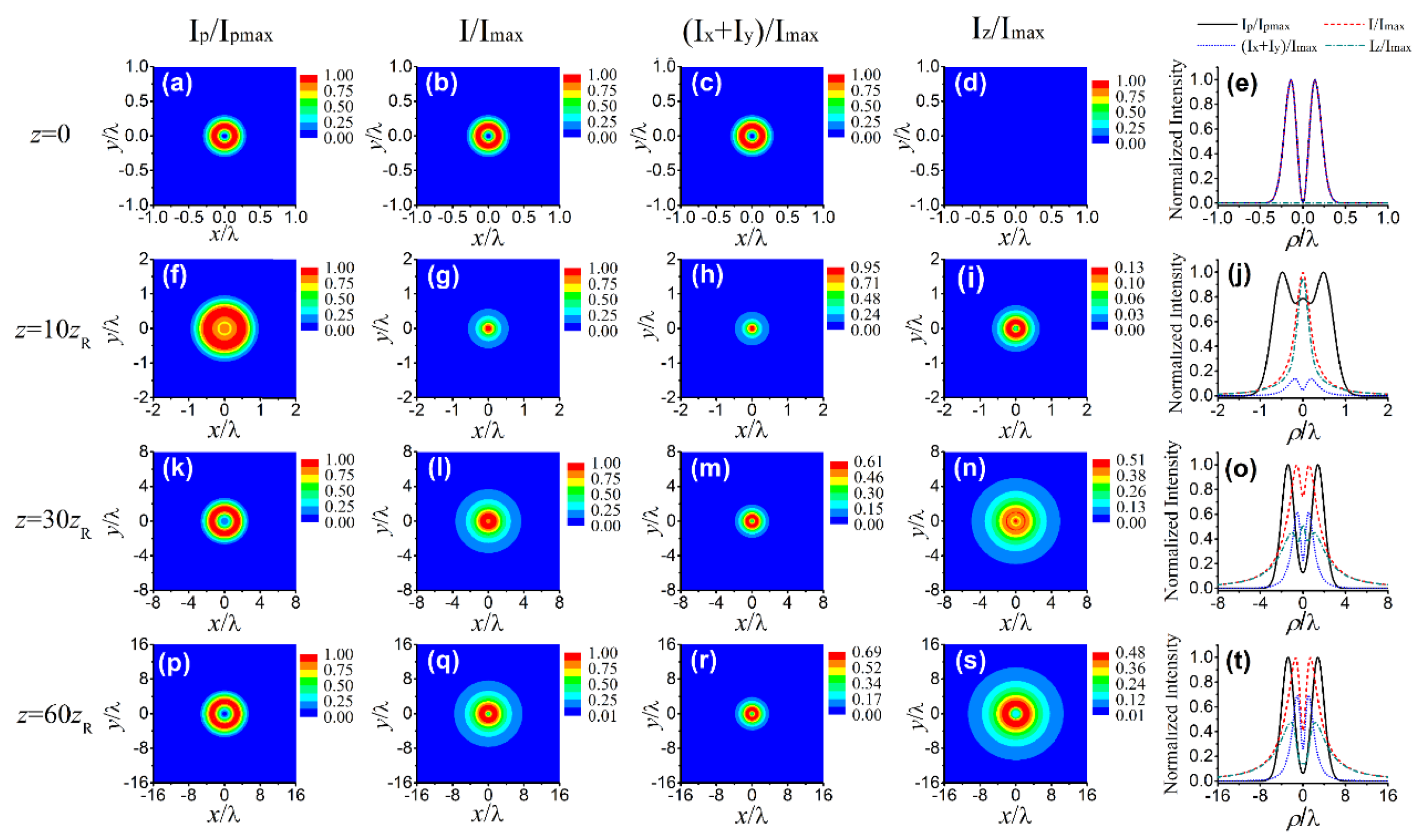
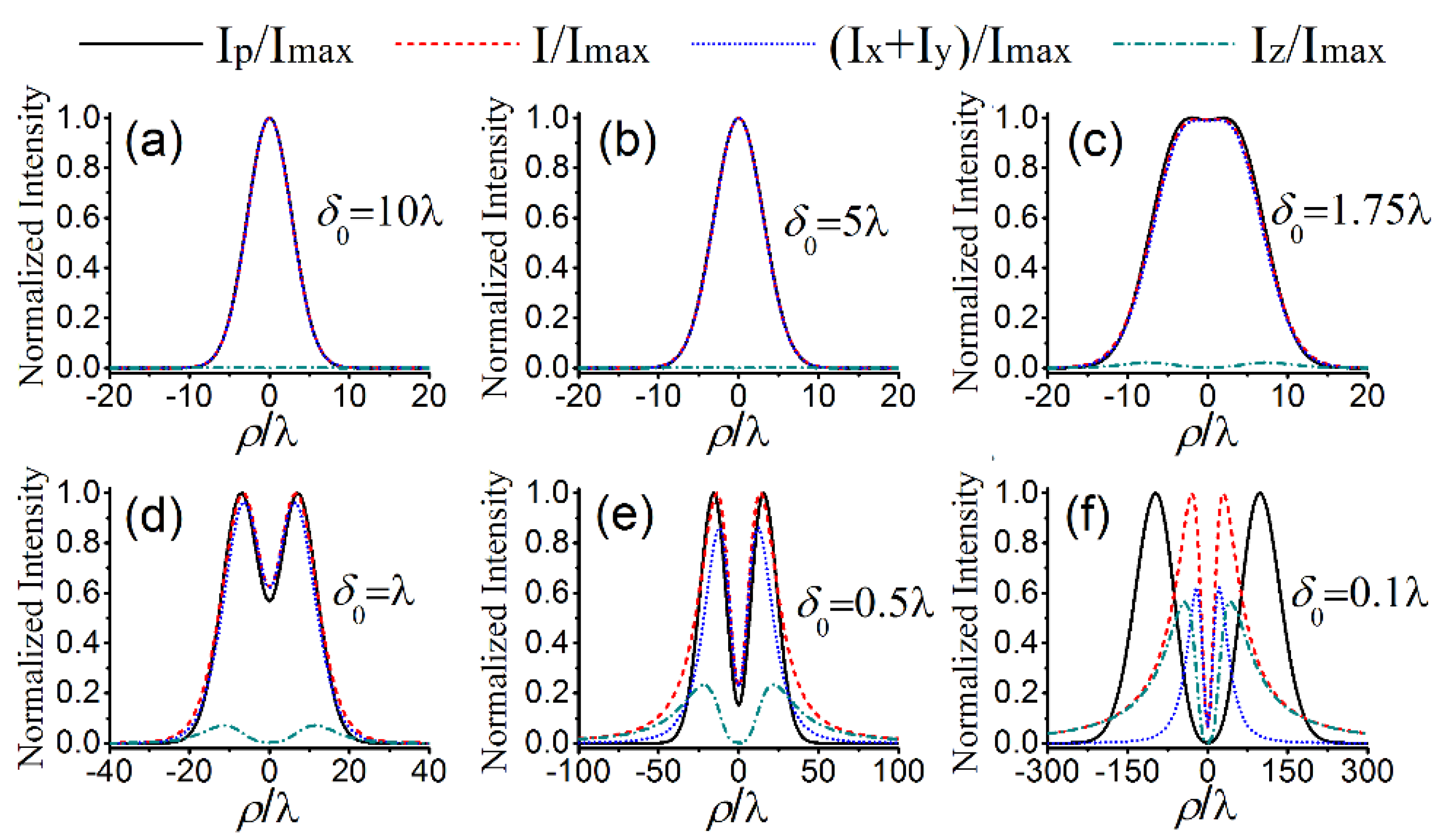
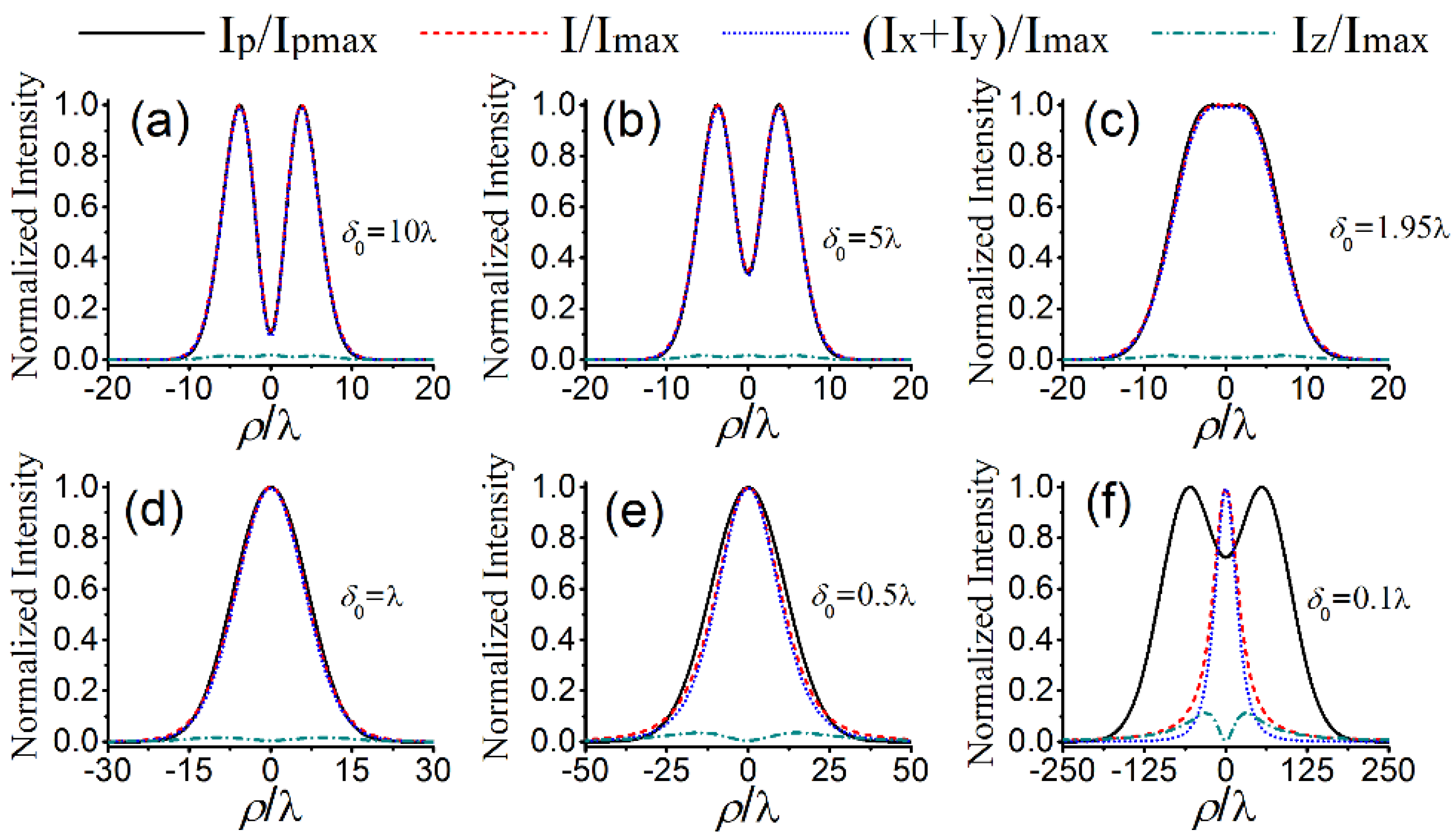
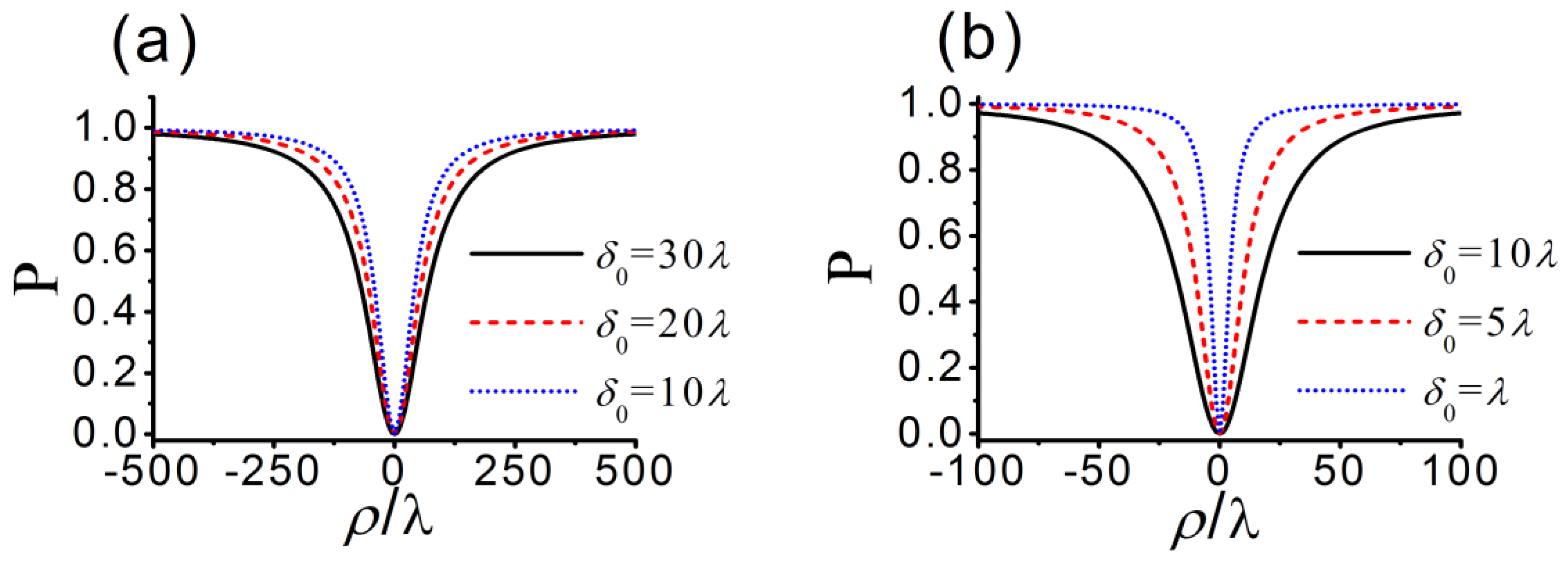
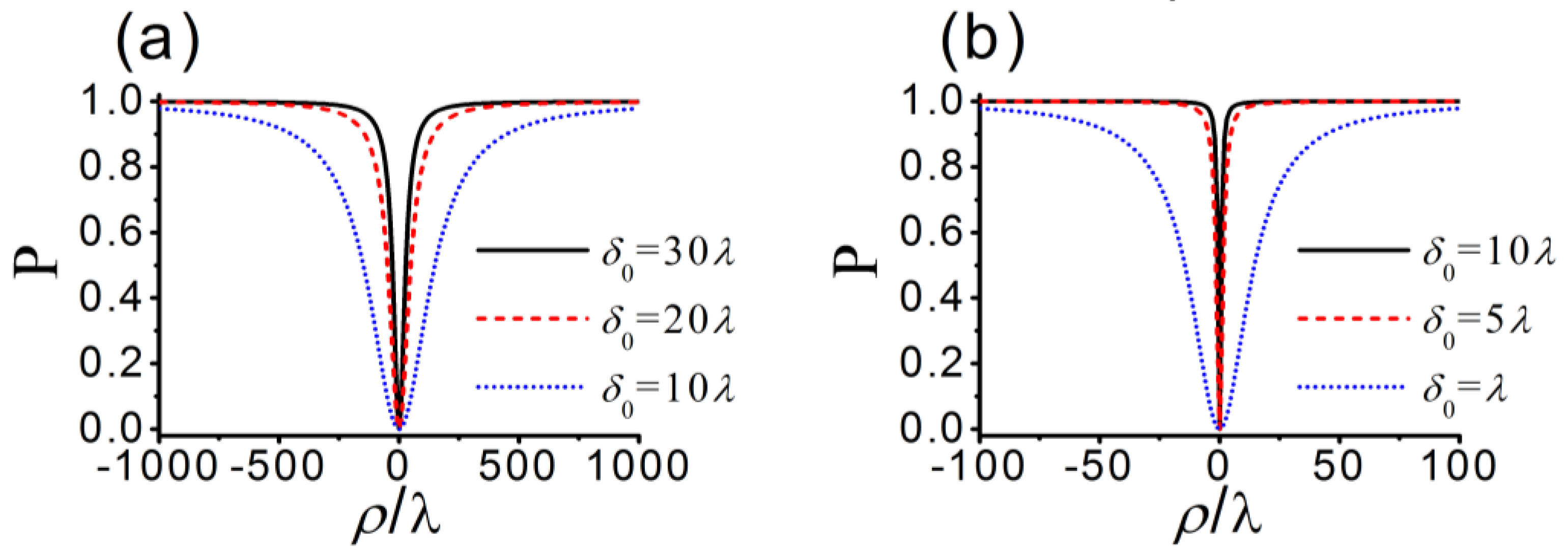

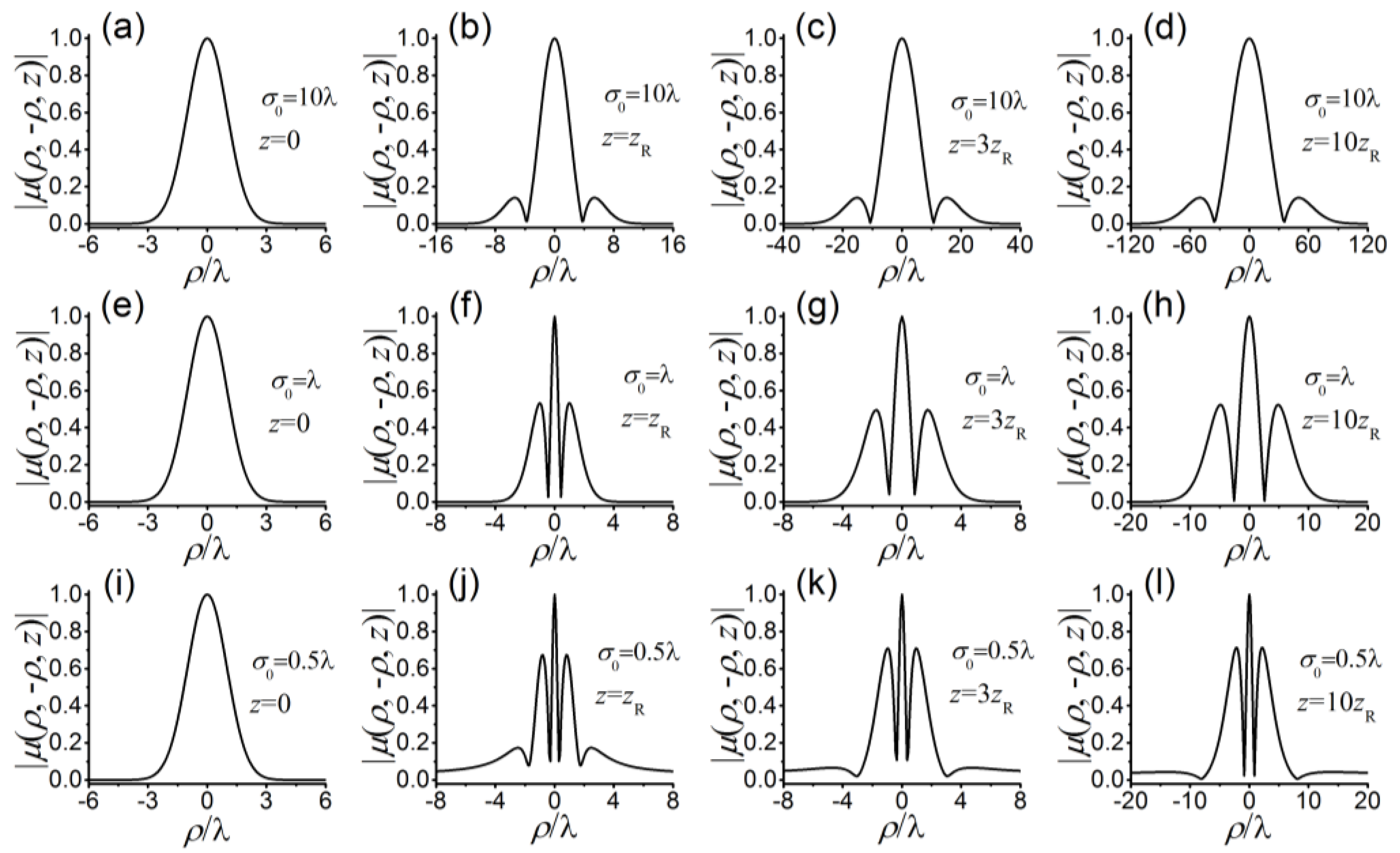
© 2019 by the authors. Licensee MDPI, Basel, Switzerland. This article is an open access article distributed under the terms and conditions of the Creative Commons Attribution (CC BY) license (http://creativecommons.org/licenses/by/4.0/).
Share and Cite
Guo, L.; Chen, L.; Lin, R.; Zhang, M.; Dong, Y.; Chen, Y.; Cai, Y. Nonparaxial Propagation Properties of Specially Correlated Radially Polarized Beams in Free Space. Appl. Sci. 2019, 9, 997. https://doi.org/10.3390/app9050997
Guo L, Chen L, Lin R, Zhang M, Dong Y, Chen Y, Cai Y. Nonparaxial Propagation Properties of Specially Correlated Radially Polarized Beams in Free Space. Applied Sciences. 2019; 9(5):997. https://doi.org/10.3390/app9050997
Chicago/Turabian StyleGuo, Lina, Li Chen, Rong Lin, Minghui Zhang, Yiming Dong, Yahong Chen, and Yangjian Cai. 2019. "Nonparaxial Propagation Properties of Specially Correlated Radially Polarized Beams in Free Space" Applied Sciences 9, no. 5: 997. https://doi.org/10.3390/app9050997
APA StyleGuo, L., Chen, L., Lin, R., Zhang, M., Dong, Y., Chen, Y., & Cai, Y. (2019). Nonparaxial Propagation Properties of Specially Correlated Radially Polarized Beams in Free Space. Applied Sciences, 9(5), 997. https://doi.org/10.3390/app9050997





